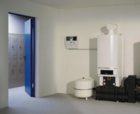Understanding NOx emissions

Understanding the conditions that lead to the formation of nitric oxide in boilers enables low-NOx boilers to be designed — such as the Buderus GB162 with NOx emissions of just 38 mg/kWh.
With BREEAM already taking account of emissions of oxides of nitrogen from boilers and Building Regulations expected to impose limits, Richard Evans explains how oxides of nitrogen are formed and how to reduce them. We hear a lot about carbon emissions and how important reducing carbon-dioxide emissions is to the environment – and quite right too. Yet we hear comparatively little about oxides of nitrogen, the family of environmentally unfriendly gases which includes nitric oxide (NO) — a by-product of gas-fired central heating boilers. Combustion requires oxygen from the air around us to react with the gas we use as the fuel. However, the oxygen content in air is only around 20%, with nitrogen representing 78% and other gases the remaining 2%. Whilst nitrogen plays no part in the combustion process, it should ideally pass through the boiler without reaction. However at temperatures over 1100°C, nitrogen and oxygen combine to form NO. As the temperature rises further the reaction speed increases sharply. If the NO is allowed to cool slowly, the gases decompose back to their original states. However, if cooled rapidly, as is the case with a condensing boiler, the NO will remain and be exhausted to the atmosphere. Once released into the atmosphere the NO reacts further with other gases and compounds leading to the formation of smog and acid rain. As environmental awareness increases, more attention is being focused on NOx (the various oxides of nitrogen,) in addition to carbon dioxide, and it is expected that Building Regulations will impose limits on NOx emissions in the near future. The good news is that some boilers have already been developed with low NOx as part of their design criteria. With well over 25 years experience in design of condensing boilers, Buderus boasts very considerable knowledge on how to reduce both CO2 and NOx emissions and has applied this technological expertise — especially on the GB162 wall-mounted condensing boiler. As can be seen from comments above, it is clearly desirable to keep the combustion temperature below the 1100°C level in as much of the combustion chamber as possible. Buderus achieves this in the GB162 by cooling the ceramic burner with the gas/air mixture as it is fed through from the fan, the burner being optimised for stability and cooling. The flames deliberately sit away from the surface of the ceramic burner to ensure the surface temperature is always low. For each burner design, the burner area must be optimised to tune the emissions for the desired heat output and modulation range. The waterways cast into the top of the aluminium heat exchanger are also used to reduce the overall temperature of the combustion chamber area. The flame pattern is kept deliberately short on the burner plate to ensure the combustion products are moved quickly away from the hottest area of the flame. The whole chamber is then optimised to remove combustion products from high temperatures, at the same time keeping the level of carbon monoxide to a minimum. The key issue in combustion design is that NO formation and CO formation are inverse, meaning decreasing NO often results in increasing CO — so the whole process has to be optimised to achieve a balance of the lowest overall emissions. Cleverly designed technology and careful attention to optimise performance has successfully achieved the extremely low emissions level for the output in the Buderus GB162. The boiler achieves a NOx emission level of just 38 mg/kWh compared to current Level 1 regulatory limits of 250 mg/kWh. As a result this boiler qualifies for additional credits assessed under the BREEAM rating scale system. As the country’s foremost authority on environment building practice, BREEAM assessments rate the environmental impact of buildings over a range of criteria of which energy use and efficiency are key factors. Credits are awarded according to performance and, application of environmental weightings, the building achieves a final score which is then rated on a scale of pass, good, very good or excellent — with certificates awarded accordingly. In this way BREEAM actively encourages improvement in the environmental aspects of buildings — an area in which Buderus can, and does, contribute significantly by advising heating-industry professionals how to achieve the most energy efficient system designs. This in turn means that NOx and carbon-dioxide emissions are minimised — for the good of all and in line with BREEAM polices and the country’s wellbeing. Richard Evans is commercial director with Buderus.
Related links:
Related articles:


